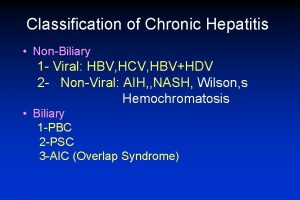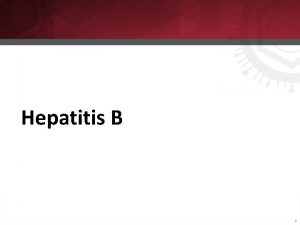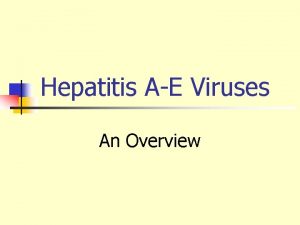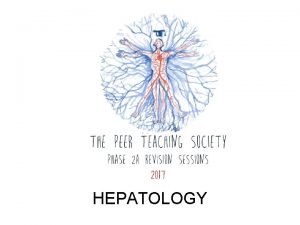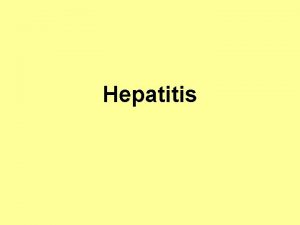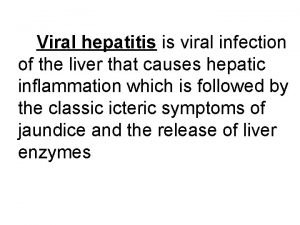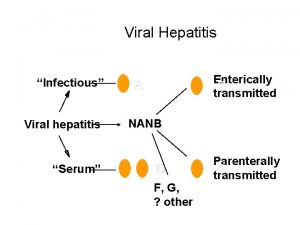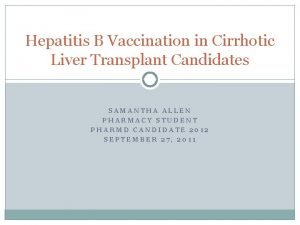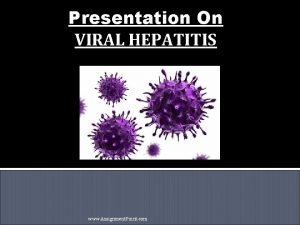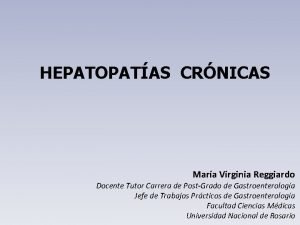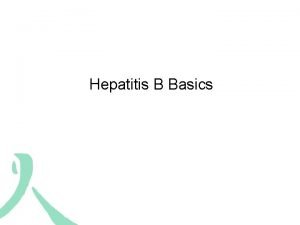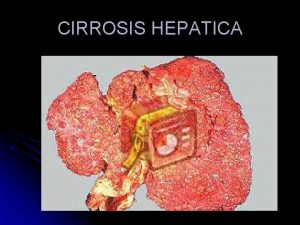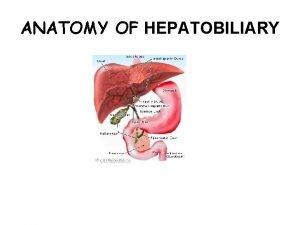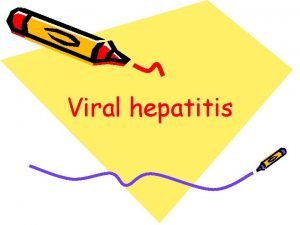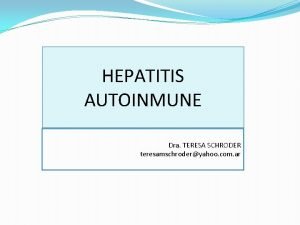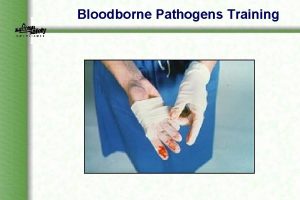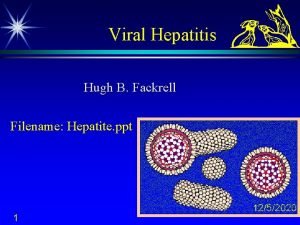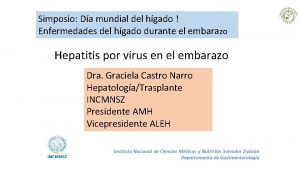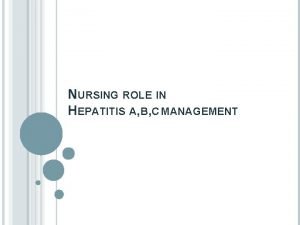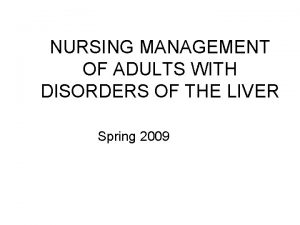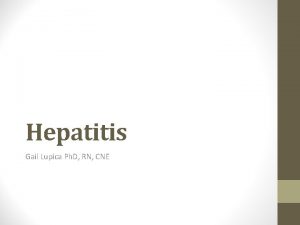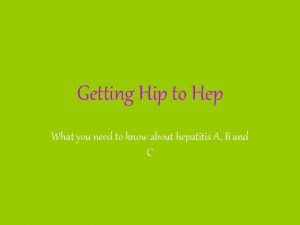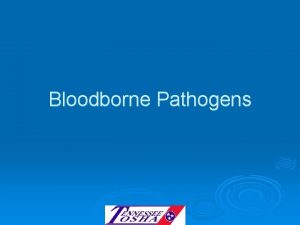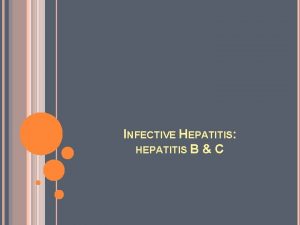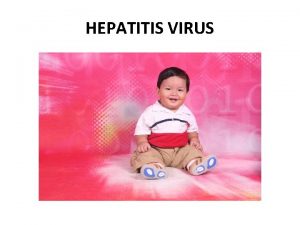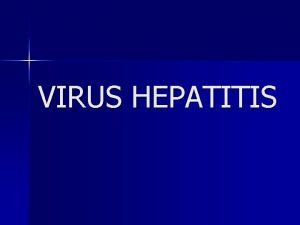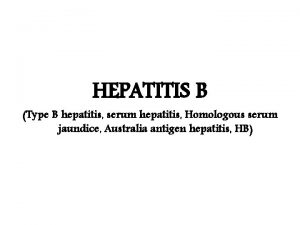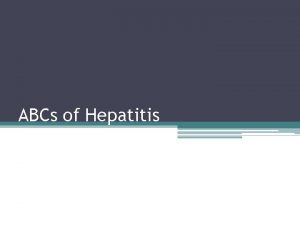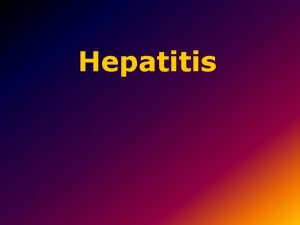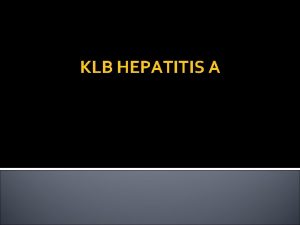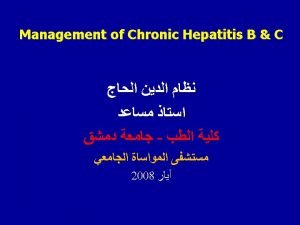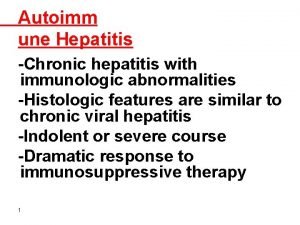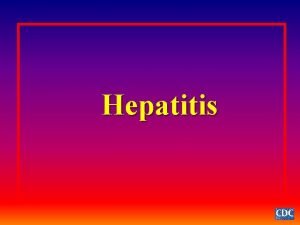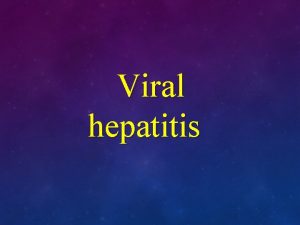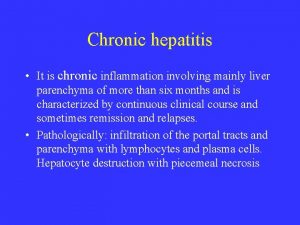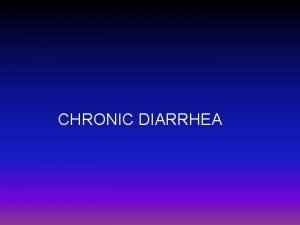Chronic hepatitises at children Definition The Chronic Hepatitis


































- Slides: 34

Chronic hepatitises at children

Definition • The Chronic Hepatitis (CH) - a diffusion inflammation of tissue of a liver lasting more than 6 months.

Functions of organelles of a cage • Membrane (cover) of a cage. The main functions – protective, transport, providing a homeostasis, division, work of proteins and the receptors located on it and B'day; • Mitokhodry – providing a cage with energy; • Goldzhi's complex – secretary function, and also neutralization of toxic products; • Endoplasmic – protein synthesis, • Kernel – storage of genetic information, division and cage regeneration.




The virologic factors influencing synchronization of process • Hepatitis virus (the greatest frequency of synchronization HCV causes) • Genotype of a virus of hepatitis • Degree of variability of a virus • Virus loading (quantity of a virus in blood unit of volume)

Virus hepatitis D • HBs. Ag is necessary for development of virus hepatitis D • Two types of a combination of VGV and VGD: • Superinfection • To - an infection

Current and VHD forecast • • Easy current – 10% The medium-weight – 20% Heavy – 45% Fulminate hepatitis – 25% Recovery comes extremely seldom Deadly outcomes – to 30% Formation of chronic mikst-hepatitis in 70% with fast transition to cirrhosis

Main pathological syndromes of diseases of a liver • Syndrome cytolysis • Syndrome inside - and extra hepatic holestasis • Syndrome of toxic defeat Syndrome of insufficiency of synthetic processes in heparcells • Inflammation syndrome

• Cirrhosis

CLASSIFICATION of CHRONIC HEPATITIS taking into account recommendations of the international group of experts (Los-Andjeles, 1994) • • • On an etiology: Virus (HVHV, HHGS, HVHD) Autoimmune (Type I, III) Drugs induced The cryptogene

• • • On activity degree: The minimum The low The moderate The expressed

• • • On fibrinotic degree: Isn't present fibroses Ill-defined fibroses Moderated fibroses Expressed fibroses Cirrhosis

• Clinical manifestations of chronic virus hepatitis's not always can be criteria of diagnostics and a weight assessment as aren't specific, aren't constant and are characterized by the general symptoms of intoxication, depend on degree of activity of hepatitis.

Features of a clinical course of chronic virus hepatitises • Long long-term current without clinical manifestations of an illness • Disease demonstration at late stages, including their complications • Possibility of development of various extra hepatic changes, including ways and pancreas, dysbiosis intestines

The objective clinical signs demanding an exception of HVG Pallor with a yellow shade of skin Palmarny erythem Telengoektazy Increase and consolidation liver Increase in a spleen

Ascyt “Caput Meduza”

Diagnostics of chronic hepatitis • At suspicion on existence sick chronic hepatitis at the doctor always has a number of problems most important of which is the following: • establishment of an etiologic factor; • specification of a clinic-morphological form of an illness; • identification of complications and accompanying diseases;

Etiologicall diagnostics • It is based on application of immunochemical and molecular and biological methods of research • The main immunochemical method - IFA • The main molecular biological method RPR

Definition of degree of activity of HVG • By results of functional tests of a liver • By results of histological research

Definition of degree of expressiveness (hepatitis stage) • Morphologically - according to a biopsy of a liver - "the gold standard" • According to ultrasonography • According to a dopplerografiya

Principles of therapy of chronic hepatitises • In treatment of chronic virus hepatitises B, D and S isn't present alternative recombinant interferon (Roferon, Pegintron, Pegasis and B'day) • Recombinant (Roferon, Pegintron, Pegasis and B'day) undoubtedly suppress replication of HBV and HCV and reduce activity of pathological process in a liver

Indications to appointment antiviral therapy at chronic virus hepatitises • 1. Ascertaining of chronic hepatitis B, C • or D (course of disease more than 6 months) • 2. Increase of activity of ALAT and ASAT. • 3. Detection of markers of replication of a virus of hepatitis B (DNA of HBV, HBs. Ag), hepatitis C • (HCV RNA), hepatitis D (HDV)

Criteria of efficiency of antiviral therapy • 1. Biochemical • Activity of ALAT. Researches are carried out monthly during treatment and within 6 months after the end of therapy; then each 6 months for 36 months. • 2. Virologic • (RNA of HCV and HBV DNA) - qualitative and quantitative methods • 3. Histological • (Positive dynamics according to a liver biopsy with use of an index of histological activity remission, incomplete remission, lack of remission)

Efficiency of standard antiviral therapy • Therapy by interferon is effective at 40 -60% of patients with virus hepatitis • At cirrhosis development - only at 20% • At 50 -60% of patients with hepatitis C standard therapy by interferon either doesn't yield results or is impossible because of high risk of development of side effects (especially at children) • At hepatitis treatment In a positive effect of therapy by interferon it is noted only at 33% of patients from which at 13% repeated reactivation of a virus after the end of treatment was observed

Basic, pathogenetic, symptomatic therapy • Diet (No. 5 on Pevznera) • Spazmolitic preparations (but-shpa, and B'day) • Hepatoprotektors (derivatives of ursodesoksikhol acid - Ursosan, Ursofalk and B'day) • In heavy cases - hormonal therapy (GKS), plasmotransfusiation, albumine, proteinaceous preparations, haemo statics, etc.

Diet: • • To exclude: Fat grades of meat, rich meat soups To limit: Fresh bread, pies with cream, smoked products, bean, chocolate, coffee, a pickles

Indications to anti-virus therapy of HVGV • Existence of active replication – HBV DNA, HBs. Ag (a "wild" strain of a virus) • High virus loading; 105 th cop/ml) • Degree fibrosis II-III.

Preparations of anti-virus therapy of HVGV at children • • • Interferon preparations: - Viferon - Roferon-A - Intron-A - Realdiron - PEG-IFN: Peg Intron, Pegasis

Choice preparation in etiotropy therapy of chronic hepatitises at children • Viferon – on 1 candle rectal each 12 hours (2 times per day) – the first 10 days. • Further – on 1 candle rectal each 12 hours (2 times per day) through

Preparations of anti-virus therapy of HVHS at children • • • Interferon preparations: - Viferon - Roferon-A - Intron-A - Realdiron - PEG-IFN: Peg Intron, Pegasis

Viferon's age dosages at treatment of chronic virus hepatitises • Newborns – children till 3 years – Viferon 1 (150. 000 ME IFN) • Children from 3 to 7 years – Viferon-2 (500. 000 ME IFN) • Children from 7 to 10 years – Viferon-3 (1. 000 ME IFN) • Children are more senior than 10 years – Viferon-4 (3. 000 ME IFN)

Medical examination at chronic hepatitises • It isn't regulated • It is carried out in policlinics in a residence, if necessary with the direction to the hepatologic, diagnostic centers, infectious diseases hospitals for profound inspection • Frequency of survey - each 6 months
 Classification of chronic hepatitis
Classification of chronic hepatitis Hbv
Hbv Chronic hepatitis
Chronic hepatitis Pbc vs psc
Pbc vs psc Hepatitis c symptoms in men
Hepatitis c symptoms in men Hepatitis comparison
Hepatitis comparison Hepatitis e
Hepatitis e Window period of hepatitis b
Window period of hepatitis b Gonorrhea
Gonorrhea Oral sex
Oral sex Dosis de hepatitis b
Dosis de hepatitis b Hepatitis alimentos permitidos y no permitidos
Hepatitis alimentos permitidos y no permitidos Hep b vaccine schedule for adults
Hep b vaccine schedule for adults Hepatitis d
Hepatitis d Porta hepatitis
Porta hepatitis Corticoides hepatitis alcoholica
Corticoides hepatitis alcoholica Hepatitis b is a silent killer
Hepatitis b is a silent killer Dosis de lactulosa en encefalopatia hepatica
Dosis de lactulosa en encefalopatia hepatica Vesica fellea anatomy
Vesica fellea anatomy Infectious canine hepatitis in dogs
Infectious canine hepatitis in dogs Hepatitis b panel
Hepatitis b panel Papillomitosis
Papillomitosis Neonatal jaundice
Neonatal jaundice Cholecystitis nursing care plan
Cholecystitis nursing care plan Score simplificado hepatitis autoinmune
Score simplificado hepatitis autoinmune Colestasis gestacional
Colestasis gestacional Hepatitis c symptoms
Hepatitis c symptoms Hepatitis types chart
Hepatitis types chart Hgado
Hgado Hepatitis symptoms
Hepatitis symptoms Nursing management of liver abscess
Nursing management of liver abscess Gail lupica
Gail lupica Ano ang pagkakaiba ng hepatitis a at b
Ano ang pagkakaiba ng hepatitis a at b Hepatitis
Hepatitis Hepatitis a treatment
Hepatitis a treatment
